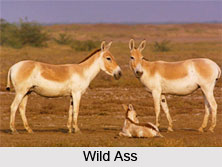 The Indian Wild Ass (Equus hemionus khur), also known as the
Khur, is a striking member of the equid family, noted for its distinctive
physical characteristics. It stands at about 100 to 120 centimeters at the
shoulder, with a body length ranging from 200 to 250 centimeters. The weight of
an adult Indian Wild Ass can vary between 250 to 400 kilograms. The coat of the
Indian Wild Ass is typically sandy or chestnut brown, which helps it blend into
its arid habitat. In winter, the coat turns paler. A prominent feature is the
dark stripe that runs along its back from the neck to the tail. Additionally,
they possess strong and slender legs, enabling them to run at speeds of up to
70 kilometers per hour, which is crucial for evading predators and navigating
their vast habitat.
The Indian Wild Ass (Equus hemionus khur), also known as the
Khur, is a striking member of the equid family, noted for its distinctive
physical characteristics. It stands at about 100 to 120 centimeters at the
shoulder, with a body length ranging from 200 to 250 centimeters. The weight of
an adult Indian Wild Ass can vary between 250 to 400 kilograms. The coat of the
Indian Wild Ass is typically sandy or chestnut brown, which helps it blend into
its arid habitat. In winter, the coat turns paler. A prominent feature is the
dark stripe that runs along its back from the neck to the tail. Additionally,
they possess strong and slender legs, enabling them to run at speeds of up to
70 kilometers per hour, which is crucial for evading predators and navigating
their vast habitat. Habitat
The Indian Wild Ass primarily inhabits the Rann of Kutch, a large area of salt marshes located in the western Indian state of Gujarat. This region is characterized by its extreme conditions, including high temperatures and scarce vegetation, making it a challenging environment for wildlife. Despite these harsh conditions, the Indian Wild Ass has adapted remarkably well. The region experiences severe climatic conditions with temperatures soaring above 45 degrees Celsius in summer and dropping to below 5 degrees Celsius in winter. The Rann of Kutch is divided into two parts: the Great Rann and the Little Rann. The Little Rann of Kutch, in particular, serves as the primary habitat for the Indian Wild Ass. This area is seasonally inundated by monsoon rains, creating temporary wetlands that support a variety of grasses and shrubs, which are essential for the diet of the Indian Wild Ass.
Concentration in India
The Indian Wild Ass once roamed extensively across the northwestern region of the Indian subcontinent, including parts of present-day Pakistan, Afghanistan, and Iran. However, their range has significantly reduced due to habitat loss, human encroachment, and hunting. Currently, the Indian Wild Ass is confined to the Indian state of Gujarat. The Little Rann of Kutch is the main stronghold, and it is within the boundaries of the Indian Wild Ass Sanctuary, established in 1972 to provide a protected environment for this endangered species. This sanctuary covers an area of approximately 5,000 square kilometers.
Conservation efforts have been increasingly successful, with the population of the Indian Wild Ass showing a positive trend. According to the latest census, the population is estimated to be around 6,000 individuals. This is a significant recovery from the brink of extinction in the mid-20th century, when their numbers had dwindled drastically. Efforts by the Forest Department of Gujarat and various wildlife organizations have been crucial in protecting and monitoring the Indian Wild Ass population. These efforts include habitat management, anti-poaching measures, and community engagement programs to reduce human-wildlife conflict.
The Indian Wild Ass is a unique and resilient wildlife species
that has adapted to the extreme conditions of its habitat in the Rann of Kutch.
Its distinct physical features, such as the sandy coat and dark dorsal stripe,
along with its remarkable speed and endurance, make it a fascinating subject of
study. While the species faces ongoing challenges, dedicated conservation
efforts have led to a promising increase in its population. The Indian Wild Ass
remains a symbol of the delicate balance between wildlife and the harsh
environments they inhabit.